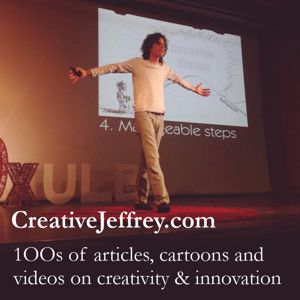Report 103
Your newsletter on applied creativity, imagination, ideas and innovation in business.
Tuesday, 15 April 2008
Issue 126
Hello and welcome to another issue of Report 103, your fortnightly newsletter on creativity, imagination, ideas and innovation in business.
As always, if you have news about creativity, imagination, ideas, or innovation please feel free to forward it to me for potential inclusion in Report103. Your comments and feedback are also always welcome.
Information on unsubscribing, archives, reprinting articles, etc can be found at the end of this newsletter.
THE THREE-Cs
During the monthly sales meeting, Arnold, a new Business Development Executive and something of a gadget freak suggested: “you know those hand-held devices the delivery people at UPS use to confirm receipt of your parcel? Wouldn't it be cool if we had a device like that so we could take clients' orders immediately and send them to production people? It would make it so much easier to make orders, there would be fewer mistakes and production could begin sooner!”
Steven, the Sales Manager smiled. He was used to outrageous ideas from the sales people. “Do you have any idea how much it would cost to equip the entire sales team with gadgets like that? Not to mention install the infrastructure for taking orders!?”
In less than a minute, Steven has not only rejected Arnold's idea, but has also ridiculed it in public. Steven has sent a very clear message to Arnold and his colleagues: this sales manager is not open to new ideas.
Yet, the scene described is highly commonplace and almost every creative thinker who has been employed in a medium to large firm has doubtless experienced it. Many of us, if pushed, will even shamefacedly admit to having been in Steven's place
Ironically, people like Steven work in companies that describe themselves as innovative and people like Steven often believe they are supportive of creative thinkers. But a couple of criticisms like the one described and the salespeople will be well trained to keep their creative ideas to themselves. So much for creativity and innovation!
How might Steven have handled the same situation better – and been more receptive to ideas? He could use an approach I call the “Three Cs”: Consider, Compliment, Challenge.
First C: Consider
In the example, Steven did not really stop to think about the idea suggested by Arnold. He gave it a quick analysis, found a flaw and rejected the idea. Such thinking, I believe, is partly the result of too many managers going through MBA courses which train students to be overly analytical and risk averse.
But analysing is not the same as considering an idea. The latter involves envisioning the implementation of the idea and how it might work. Analysing is more of a score-sheet which gives a pass-fail mark. And if it fails, it fails.
Second C: Compliment
Compliments are wonderful things! I try to use them all the time. Compliments make people feel good about themselves and what they are doing. Compliments motivate people to continue to be deserving of the compliment. As a manager, I prefer people to act in the hope of being complimented rather than in fear of being criticised.
Having considered the idea, the manager should compliment it. Ideally, the consideration will generate the compliment. In the case above, “I'm glad you are looking at ways to make the sales process more efficient” would be a good, relevant compliment. But, if nothing else, saying: “that's a good idea.” or “it's good you are thinking creatively” are useful standbys.
Third C: Challenge
Having considered an idea and complimented it, the final step is for the manager to challenge the idea suggester to improve the idea. In particular, the manager should look at the issue that wants to trigger criticism. In the example above, it would be the cost of implementing the idea. Then twist that problem into a creative challenge.
In Steven's case, a far more effective response would be to think for a moment and then say: “Thanks, Arnold. That's a terrific idea and I especially like the fact you are looking at ways to streamline the ordering process. But, the cost of custom making hand-held devices for a relatively small team like ours would probably be way too high. Can you think of ways we might accomplish the same thing but with a reasonable budget?”
In this second scenario, Steven has complimented Arnold in front of his colleagues, has indicated to everyone in the meeting that he is open to ideas and has challenged Arnold to think about his idea in more detail and solve problems that might prevent its implementation.
In a group environment, the Sales Manager might even invite everyone in the room to think about the challenge. And by starting the discussion on a positive note, the manager encourages team members also to take a more positive approach.
Of course, Arnold might find that there is not a viable solution or he may simply not be motivated enough about the idea to take it further. But even if that is the case, he has been motivated to continue being creative. And that is critical for companies that claim to be innnovative.
The Three-Cs is a simple, yet remarkably powerful method of establishing an innovation friendly environment in any organisation. Indeed, I have over the years delivered this as a short workshop or a component of a larger training event on several occasions – and the results have always been impressive.
FOLLOW UP ON VISUAL BRAINSTORMING
I wrote about visual brainstorming in Report 103 some months ago (http://www.creativejeffrey.com/creative/visual_brainstorming.php). It is a process of generating ideas non-verbally, such as by drawing, building or role-playing to find solutions to a creative challenge.
A couple of weeks ago at the Brussels Imagination Club, I ran an experimental short workshop on visual brainstorming. This included a short, open lecture on verbal brainstorming, its history, its flaws and the theory behind visual brainstorming. This was followed by a mini-brainstorming session in which workshop participants were divided into three groups of six or seven people each.
The Challenge
All groups had the same challenge: “Imagine that the Imagination Club has received €10 million in EU funding to build its headquarters in Brussels. You are in charge of designing the facility. You have 20 minutes to generate ideas, after which you will be asked to present your ideas to everyone.”
The first group was asked to do a traditional verbal brainstorming session. The second group was given a large whiteboard and lots of markers and asked to draw a floor plan. The third group was given a large box of children's wooden building blocks and told to design an HQ.
The Results
After 20 minutes, all groups presented their ideas. The results were interesting and very creative from all groups. But then the Imagination Club is always creative.
Most interesting was the format of the results. The verbal group presented a list of varied ideas – although there were some clear themes. The two visual groups each presented a more comprehensive concept and both group were able to weave stories around their concepts. This was not possible with the verbal group's varied idea list.
Not surprisingly, the building block group was the most physically active with participants moving around the table, talking to each other and adding to their structure in varied ways. Even though their result was in the form of a cohesive concept, there was also varied thinking and many components of their work were not directly related to the concept. In other words, the concept did not obviously inhibit creative thinking. Also, in this group, everyone (with one exception) participated in building the HQ.
The whiteboard group also involved physical movement, but the board tended to be dominated by several group members. And while they did not prevent anyone form adding to the drawing – at least one group member (who has new) largely stood back and watched rather than participated.
The verbal group was the least physically active, of course. Everyone stayed in their seats. Although everyone participated, a core group contributed the majority of the ideas – as is often the case on verbal brainstorming.
Devising Strategies
I mentioned above that one member of the building block group did not participate. In fact, she felt uncomfortable in the group because she was not clear on what she should be doing. I moved her to the verbal group – which was a more familiar environment and she quickly participated.
This was an issue which was discussed in some detail at the end of the workshop and even resulted in some debate. I purposely did not give precise rules to the brainstormers. The unhappy building block person and another participant said they were not entirely comfortable about the lack of directions and felt that in a real environment (such as in a company), there should have been more precise instructions for each group.
A couple of other people argued –- as I did –- that the lack of precise instructions gave them more freedom to solve the problem in their own way. We felt this was better for creative problem solving.
Indeed, as a result of the vague instructions, each group had to devise a strategy before members could begin idea generation. For the verbal group, this was easy. Everyone was familiar with brainstorming and had participated in brainstorming activities in the past. So, it was a matter of assigning tasks and getting started.
The other two groups had to spend more time devising a strategy between themselves in order to move forward. This was interesting and clearly a part of the creative process. It is also worth noting that a significant part of the strategy development involved actions rather than words.
The person who left the building block group eventually conceded that if it had been clearer that groups were free to solve the problem in any way, she might not have been as uncomfortable. This is worth noting. In idea generation activities, if there are no rules: be sure to clarify that rule one is: there are no rules!
The Brussels Imagination Club
The Brussels Imagination Club is an informal group which I co-manage. We meet twice a week in Brussels to run mini, experimental workshops that are somehow related to creativity and innovation (sometimes very loosely!). In addition, we occasionally hold cultural activities on Sunday afternoons. The group is very international. A typical event includes 16-24 people and seldom are more than two people from the same country! More information about the Brussels Imagination Club can be found at http://brussels.imaginationclub.org. Our next event is tomorrow (Wednesday, 16 April) on the subject: Hypnotise with PowerPoint http://brussels.imaginationclub.org/event20080416.php
THE MYTH OF THE LONE INVENTOR
As someone who knows a thing or three about organisational innovation, I am always amazed at the persistent myth of the lone inventor who invents something wildly innovative by accident and by himself (why is the lone inventor always a male?). Even the business press, which should know better, persists in believing that the lone inventor is behind many great inventions.
The truth is quite the opposite. Almost every great innovation is the result of collaborative creativity and development. Interestingly, many of these collaborative innovations start from ideas first considered failures. Let's look at two famous business innovations.
Post-Its
Any story of business innovation has to include Post-Its. Their history started with the invention of not-so-sticky glue by Spenser Silver, a chemist who was experimenting with different glue mixtures. He toyed with the idea a bit, but could not come up with any practical use for it. Fortunately, he shared the idea with his colleagues. Otherwise, Post-Its might never have been invented.
From there a couple of internal champions, highly placed in the company, kept Silver's invention alive. Finally, another scientist, Arthur Fry, noticed that the not-so-sticky glue on small squares of papers made excellent bookmarks in his hymnal (he was a regular singer at his church). From there a host of different people from different divisions got involved in developing the idea, selling it within the company and then selling it to customers. Along the way were a number of creative approaches to product development and marketing. You can see some of the many participants at http://www.3m.com/us/office/postit/pastpresent/history_pl.html
The Sony Walkman
If you are in your mid-30s or older, you will doubtless recall the impact of the Sony Walkman, a portable cassette tape player you could strap to your belt and listen to via headphones while on the move. In the early 1980s they were as ubiquitous as today's Ipods and MP3 players. Just about every teenager had one. And soon other companies were copying the concept. Nevertheless, the team who invented it thought they had failed.
In the late 1970s, Mitsuro Ida and his team of electronic engineers were collaboratively working on improving the “Pressman” a small portable tape recorder. The Pressman was popular among journalists who valued its small size and portability. Ida's team was trying to make it even smaller.
In 1978, they failed. They had come up with a great miniature case – but the could not fit all of the components inside. They could only squeeze in the playing, rewind and fast-forward bits. But, no matter how much they tried, they could not fit the recording parts inside the case. On a positive note, however, they did manage to get the prototype to play in stereo.
Ida's team went back to the drawing board feeling that they had failed. Their task was to make tape recorders, not players. Nevertheless, some of the engineers found their failures useful for playing music while they worked.
As with the scientists at 3M, the engineers at Sony shared their idea. Which was fortunate, because honorary chairman Masaru Ibuka, while checking on the progress of engineering teams in Sony, saw the Pressmen engineers listening to music on their tape player on the same day as he had seen another group working on lightweight headphones. He realised the potential of marrying these two devices and the rest, as they say, is history. Indeed, the iPod can certainly trace its roots to the Sony Walkman.
Lessons to Be Learned
In each of these highly innovative products, the original inventor was part of a team and did not see his discovery as being particularly important. Only through enterprise-wide collaboration was a more innovative use for each invention found. And then, again through collaboration, the product was modified to suit the new use.
The lessons to be learned here are clear:
-
Innovation is a collaborative venture that should involve people from all corners of the enterprise, and not just the research people.
-
Great ideas are sometimes not recognised at their early stages and especially not by their inventors. Communication and collaboration are critical to turn these germs of ideas into successful products – and hence innovations.
Idea Management and Suggestion Schemes
In spite of the collaborative effort behind most significant innovations, it is amazing how many suggestion schemes and idea management tools are designed around an individual submitting an idea in a closed environment where her colleagues cannot see her idea or collaborate on it. Only a manager reviews the idea in order to determine whether or not to develop the idea further. If 3M and Sony had used such an approach to creative thinking in the 1970s, it is very likely that neither Post-Its nor the Walkman would have been invented by their companies.
Fortunately, collaborative idea management tools exist. Indeed, by remarkable coincidence, my company has developed and markets what we believe to be the most openly collaborative idea management tool available: Jenni (http://www.creativejeffrey.com/jenni/). Indeed, ideas can even be developed in Jenni's unique IdeaWiki tool – a sort of easy to use mini-wiki that allows open, cross-enterprise collaboration. And, of course, Jenni has been developed through collaboration internally, with sales partners and with clients.
LATEST IN BUSINESS INNOVATION
If you want to keep up with the latest news in business innovation, I recommend Chuck Frey's INNOVATIONweek (http://www.innovationtools.com/News/subscribe.asp). It's the only e-newsletter that keeps you up-to-date on all of the latest innovation news, research, trends, case histories of leading companies and more. And it's the perfect complement to Report 103!
Happy thinking!
Jeffrey Baumgartner
---------------------------------------------------
Report 103 is a complimentary weekly electronic newsletter from Bwiti bvba of Belgium (a jpb.com company: http://www.creativejeffrey.com). Archives and subscription information can be found at http://www.creativejeffrey.com/report103/
Report 103 is edited by Jeffrey Baumgartner and is published on the first and third Tuesday of every month.
You may forward this copy of Report 103 to anyone, provided you forward it in its entirety and do not edit it in any way. If you wish to reprint only a part of Report 103, please contact Jeffrey Baumgartner.
Contributions and press releases are welcome. Please contact Jeffrey in the first instance.




